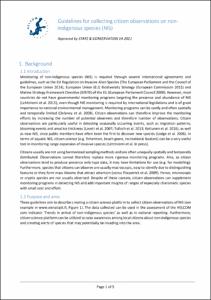| dc.coverage.spatial | Baltic Sea | en_US |
| dc.date.accessioned | 2022-07-21T14:47:28Z | |
| dc.date.available | 2022-07-21T14:47:28Z | |
| dc.date.issued | 2021 | |
| dc.identifier.citation | HELCOM (2021) Guidelines for collecting citizen observations on non-indigenous species (NIS). Helsinki, Finland, HELCOM, 5pp. DOI: http://dx.doi.org/10.25607/OBP-1824 | en_US |
| dc.identifier.uri | https://repository.oceanbestpractices.org/handle/11329/2029 | |
| dc.identifier.uri | http://dx.doi.org/10.25607/OBP-1824 | |
| dc.description.abstract | Monitoring of non-indigenous species (NIS) is required through several international agreements and guidelines, such as the EU Regulation on Invasive Alien Species (The European Parliament and the Council of the European Union 2014), European Union (EU) Biodiversity Strategy (European Commission 2011) and Marine Strategy Framework Directive (MSFD) of the EU (European Parliament Council 2008). However, most countries do not have governmental monitoring programs targeting the presence and abundance of NIS (Lehtiniemi et al. 2015), even though NIS monitoring is required by international legislations and is of great importance to national environmental management. Monitoring programs can be costly and often spatially and temporally limited (Delaney et al. 2008). Citizen observations can therefore improve the monitoring efforts by increasing the number of potential observers and therefore number of observations. Citizen observations are particularly useful in detecting seasonally occurring events, such as migration patterns, blooming events and areal ice thickness (Lovett et al. 2007; Tulloch et al. 2013; Kettunen et al. 2016), as well as new NIS, since public members have often been the first to discover new species (Lodge et al. 2006). In terms of aquatic NIS, citizen science (e.g. fishermen, beach goers, recreational boaters) can be a very useful tool in monitoring range expansion of invasive species (Lehtiniemi et al. In press).
Citizens usually are not using harmonized sampling methods and are often unequally spatially and temporally distributed. Observations cannot therefore replace more rigorous monitoring programs. Also, as citizen observations tend to produce presence only-type data, it may have limitations for use (e.g. for modelling). Furthermore, species that citizens can observe are usually macroscopic, easy to identify due to distinguishing features or they form mass blooms that attract attention (sensu Fitzpatrick et al. 2009). Hence, microscopic or cryptic species are not usually observed. Despite of these caveats, citizen observations can supplement monitoring programs in detecting NIS and add important insights of ranges of especially charismatic species with small cost and effort.
These guidelines aim to describe creating a citizen science platform to collect citizen observations of NIS (see example in www.vieraslajit.fi, Figure 1). The data collected can be used in the assessment of the HELCOM core indicator ‘Trends in arrival of non-indigenous species’ as well as in national reporting. Furthermore, citizen science platform can be utilized to raise awareness among local citizens about non-indigenous species and creating alerts of species that may potentially be invading into the area. | en_US |
| dc.language.iso | en | en_US |
| dc.publisher | HELCOM | en_US |
| dc.subject.other | Sampling | en_US |
| dc.subject.other | Monitoring | en_US |
| dc.subject.other | Non-Indigenous species | en_US |
| dc.subject.other | Citizen Science | en_US |
| dc.title | Guidelines for collecting citizen observations on non-indigenous species (NIS). | en_US |
| dc.type | Report | en_US |
| dc.description.status | Published | en_US |
| dc.format.pages | 5pp. | en_US |
| dc.contributor.corpauthor | HELCOM | en_US |
| dc.description.refereed | Refereed | en_US |
| dc.publisher.place | Helsinki, Finland | en_US |
| dc.subject.parameterDiscipline | Biological oceanography | en_US |
| dc.subject.dmProcesses | Data acquisition | en_US |
| dc.description.currentstatus | Current | en_US |
| dc.description.sdg | 14.a | en_US |
| dc.description.maturitylevel | Mature | en_US |
| dc.description.adoption | Multi-organisational | en_US |
| dc.description.adoption | International | en_US |
| dc.description.methodologyType | Method | en_US |
| dc.description.methodologyType | Specification of criteria | en_US |
| obps.endorsementAuthorDeclared.deJureStandard | HELCOM | |
| obps.contact.contactemail | info@helcom.fi | |
| obps.resourceurl.publisher | https://helcom.fi/helcom-at-work/publications/manuals-and-guidelines/ | |
 Repository of community practices in Ocean Research, Applications and Data/Information Management
Repository of community practices in Ocean Research, Applications and Data/Information Management
